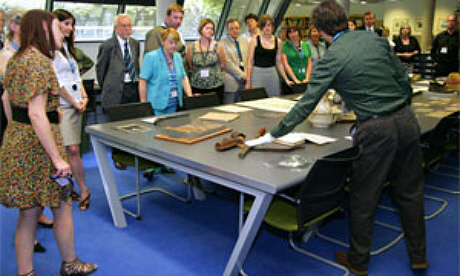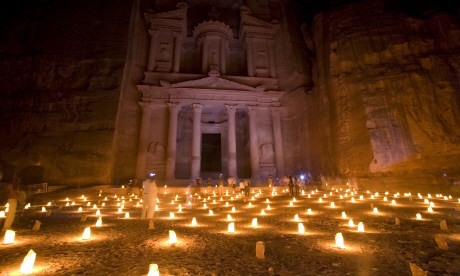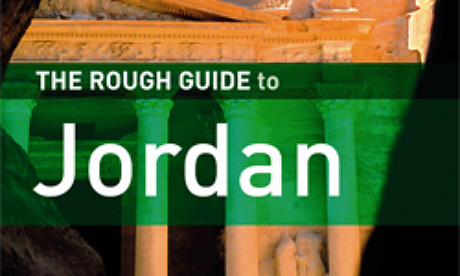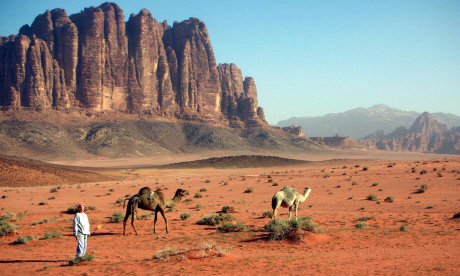
RGS insider, Alasdair Macleod, reveals all about the Society's amazing collection of geographical artefacts - and how you can see them
Last Tuesday night the Royal Geographical Society held an event in conjunction with Wanderlust to celebrate the 200th anniversary of the 'rediscovery' of Petra by John Lewis Burckhardt.
To mark the occasion, the Society had laid out a selection of Petra-related artefacts from its collection – hand drawn maps, correspondence in spidery script, T.E. Lawrence's sweaty head scarf – all within touching distance.
It was merely a fraction of the incredible treasures the Society has tucked away, and afterwards Peter Moore spoke to Alasdair Macleod about the Society and its collection of geographical-related artefacts.
How big is the Royal Geographical Society collection?
The collection numbers over 2 million items. We’ve got the largest collection of maps, charts and atlases in the world, which is over 1 million items strong. We’ve got about half a million photographs and other forms of images like paintings and watercolours.
We’ve also got roughly 1,200 to 1,500 artefacts. Everything from the breathing apparatus that was used to climb Everest in the 50s through to Charles Darwin’s pocket sextant which he carried with him on the Voyage of the Beagle.
Beyond that we have archive collections of materials that relate to expeditionary history, whether that’s David Livingstone’s notebooks and letters like those on display at the Petra evening, from Jean Louis Burckhardt.
So it’s a very broad ranging collection. And it’s open to the public as well.
How are these items acquired?
Well, the Society was founded in 1830 and it had a very clear set of guidelines for collections. It wanted to collect maps and books that would inform future travellers. So from the time of its very foundation it acquired a lot of mapping. That mapping came largely from the Admiralty, but they also have sources in Europe, maps and charts that came from France, the Netherlands and other countries.Then the society gradually began to acquire more and more atlases and books and other writings.
But, as I said, from the very beginning the role of the Society, as it is today, is to inform people about the world around them, to give them the opportunity to come and research in the Society’s library. Obviously, these days, people can do a lot of that work online.
Do you accept everything that is offered to you?
We have a limited amount of space, but we’re very welcoming of approaches from people. The first thing we do is check that we don’t already have something, although, sometimes, it can be useful to have a duplicate of items we already have in our collection.
Some areas of the collection are growing.We regularly receive offers of photo collections. And they’re often very surprising and complement what we’ve already got.
For example, we recently we had a donation of photographs of Dubai from the 1950’s. The landscape has changed beyond measure, so for anyone coming to do research those pictures will be of great value.
What about the more physical objects? Where do you keep them?
Everything is kept on site in purpose-built stores. We were very fortunate in 2004 to have a program called ‘Unlocking the Archives’ which enabled the society to build new storage for its collections and to develop the reading rooms so that people could come and use them. That was supported by the Heritage Lottery Fund and a number of other sponsors and supporters.
It has meant that we have been able to preserve the collections for the benefit of future generations and also to promote the collection, particularly around educational programs for schools and lifelong learners.
What would you say is the Society’s most prized artifact is?
There are so many different things. It would be hard to say.
Do you have a personal favourite?
The most inspirational piece to me is a sketch of Victoria Falls done by David Livingstone. He was the first European known to have seen the Falls and there’s something very special about it. It is very inspirational – his response to seeing those wonderful falls for the very first time. Just in terms of the groups that come in and use those collections, they may often be from diaspora communities coming in and looking at their own heritage.
One of the great things about Tuesday night was seeing these wonderful objects in front of you – TE Lawrence’s scarf, these amazing hand-written letters. With a lot of modern stuff coming in digitised form, is a printed out email going to have the same impact on future generations?
We’re still very much collecting physical items.
In terms of digital collections, most relate to projects we have done with an exhibition or something like that. So you have contemporary images used in connection with the historical material.
So they help tell a story of change. We are a repository of images of places that may be changing or vanishing and think that’s one of our key roles, to hold it in archive form for the future.
You hold a series of collection-related events. How are they themed?
We have three terms at the Society and we do one collection-related event each term. They are open to everybody. You don’t have to be a member of the Society to come along. And they tend to be linked in to the themes of our exhibition program or into an aspect of something the society may be working on at the present time.
In this autumn’s program we’ve got a new series on Henry Morton Stanley in Africa, one of the very famous figures in early African exploration, which is linked into a recent long-term loan of some material relating to Stanley. And we also have one on the picture library collection itself, on recent acquisitions we have made to the collection.
I noticed there’s something on Frank Wild coming up as well.
That’s an evening display that’s linked into one of the Monday night lectures, so that’ll be open to Members only. There’s one of those lectures held once a month in each term and we pick a particular lecture on a theme where we know we’ve got a very rich collection .
We’ve got one about five centuries of mapping India in October and then one on Brazil in December.
What if someone wanted to see a particular object, say TE Lawrence’s scarf for example? Do they have to wait for a related exhibition?
No. People can just come in at any time. We’re open, Monday through Friday from 10 until 5.
Anyone who is involved in education, whether they’re at school doing GSCEs or A-levels, right through to Master’s students and post-doctoral students, can come for free, as long as they have evidence of their student status. Members of the general public are very welcome to come as well, but we do charge a £10 fee for a visit.
What people tend to do is this: if they think there is some sort of material here that they want to do some research on, they can look at the catalogue for the Society online and do a bit of pre-research, then ring up my team in the Reading Room and establish exactly what we’ve got that would be relevant for them and then come and do a day or half a days research.
That means they can have access to pretty much everything we have. There are very few closed collections which are items that are too fragile to be brought out. But yes, it would be very easy to come and see the TE Lawrence scarf by arrangement in that way.
What’s your role in the Society?
I manage the Reading Room and the Collections team. We have a whole team of people with expertise in maps or in archives material or in photographs. I’m also involved in the enterprise side of the Society, organising travel events, licensing content for books and filming and we license image use as well. Because we are a private charity that makes a significant contribution to our finances.
With regards to the collections, do you have a particular area of expertise? You seemed very knowledgeable about what was on display at the Petra event.
We have some pretty key collections and it’s a great privilege in my role to actually help interpret those for visitors. But the areas I’m most interested in terms of previous showcases and exhibitions that we have done would be the search for the North-West Passage and also Polar displays. But there are people here who know much more than me.
What upcoming event are you most excited about?
One of the most exciting we’ve got coming up is one in our ‘Discovering Places’ series, a travel series run by the Society. It's on November 20 and it’s about Myanmar. On those evenings we have first-hand experiences from travel writers or travellers and it’s a great opportunity for people to network with the speakers and learn more about the destinations.
And what sort of things will you be pulling out of the cupboard, so to speak?
We’ll probably be looking at some of the very early mapping. One of the speakers is going to be looking at North-West Burma and I’m pretty sure we’ve got some great photographs of that area.
 The Royal Geographical Society is the UK's learned society and professional body for geography, founded in 1830. Its aim is to advance geography and support its practitioners in the UK and across the world, and it holds over 150 events each year. For more details visit its website.
The Royal Geographical Society is the UK's learned society and professional body for geography, founded in 1830. Its aim is to advance geography and support its practitioners in the UK and across the world, and it holds over 150 events each year. For more details visit its website.
For more travel secrets from the world's most famous wanderers, visit our Interviews page.
 Ultimate Top 5 Guide: Petra and Wadi Rum
Ultimate Top 5 Guide: Petra and Wadi Rum
It’s 200 years since the rediscovery of Petra – high time to rediscover this rock-hewn city, and the nearby deserts of Wadi Rum, for yourself More
 Top 7 books to take to Petra
Top 7 books to take to Petra
Today marks the 200th anniversary of the rediscovery of Petra. Stanfords showcases the top books, guides and maps to take on your trip to the iconic site More
 Petra and Wadi Rum: life in the desert
Petra and Wadi Rum: life in the desert
Way off the tourist trail, Paul Morrison discovers the real secrets of Petra and experiences life in the desert More